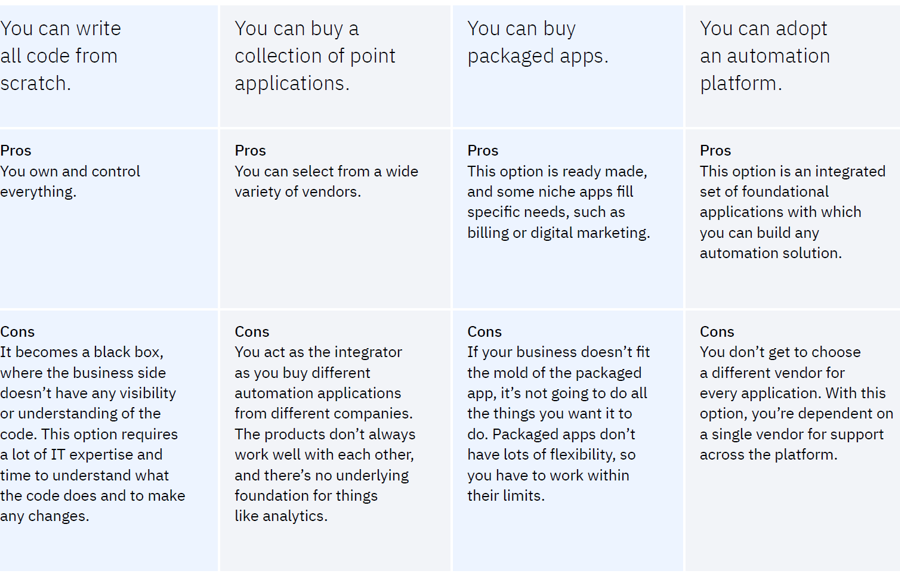
Automating work: part 3
Added Friday 21 January 2022
If you want to invest in automation technology, it’s commonly recommended that you start with a pilot that can deliver rapid results, with minimal implementation risks. This approach helps make a strong case for scaling up, but consider the following recommendations:
Pick a significant, but not mission-critical project
Find an example that will be worth the effort and demonstrate value when completed. Don’t pick a project that can break everything!
Begin with an end in mind
Ensure the first project is a front or back-office operation, important to the business, that you’ve mapped out the desired state or experience. Look at the leaders in your industry – especially those who are growing fast – to see what’s possible. Keep in mind you’re looking at all of their work, which may include dozens of individual automation projects that add up to a transformative approach.
Pick one or two projects as a starting point. Make each project individually valuable, knowing that as they build and interconnect, the benefit can be exponential.
Take advantage of the Cloud
Work with us to invest in a short term cloud environment for development purposes that avoids you having to sink significant infrastructure costs and allows you to walk away or easily change direction if things don’t go according to plan.
Moreover, if you have some automation already, consider a customer journey that uses two Business Automation entry points rather than just one. For example, improve a customer journey using Document Processing and Robotics or a simple Workflow with a Chatbot as a customer communication channel.
Six questions to help you decide where to start
In a large business, you might have dozens of potential automation projects, which means choosing where to start can be paralysing. The following questions aren’t exhaustive, but they can help you and your team focus on the right starting point:
- How quickly do you respond to customer requests?
- How does your customer experience compare to other leaders in the industry, including your born-digital competitors?
- Do your employees spend a significant portion of time doing prescriptive manual work that could be automated?
- Do your competitors offer more products and services targeted at specific niches in the market than you?
- Can you rapidly modify your front and back-end software applications as customer expectations and government regulations change?
- What percentage of customer transactions result in exceptions that must be manually processed?
What are your solution options?
So, if you’re ready to start shopping for an automation solution, you basically have the following four options, which many companies mix and match:
Automation Solution Options

AI and Automation
Applying artificial intelligence (AI) directly to automation is still in the early stages, but it won’t be for long. It’s a good idea to start figuring out how to apply AI to your automation projects and take the opportunity to experiment and build skills before your competition does.
Three examples of how leading companies are using AI to automate work
1: Using AI in automation to improve the quality of decision-making.
For example, Insurers want to know the probability of a claim being fraudulent, even when there’s no easily discernible evidence of fraud. The AI system can be trained over time to become more effective at identifying fraud, helping the company to pay claims faster and at the same time reduce risk. Consider two similar claims for a medical procedure in which both claims conform to all the insurance policy’s rules.
First insurance claim example
- AI detects no concerning pattern
- The company can pay the first claim without incurring the time and cost of more investigation— thus increasing customer satisfaction and reducing costs
Second insurance claim example
- AI detects a hidden pattern that indicates a suspicion of fraud
- The company can send the second claim for further review
2: Using AI in automation to detect and act on hidden patterns in the data collected by operational systems.
This “operational data” provides new insights not provided by traditional data sources. Consider a product development application where hidden insights signal that changes to a specific part have a high likelihood of resulting in a production delay. These hidden implications can be based on a complex web of interdependencies that couldn’t have been uncovered without AI. Operational data can provide insights in virtually every industry by helping to answer such questions as:
- How long did it take to open a new account and why?
- How often did I miss my SLA and why?
- How much rework was required and why?
You can improve automation by using these unique insights to accelerate customer-facing processes, shorten delivery times and reduce rework.
3. Using AI in automation for intelligent data capture.
For example, a company needs to standardise invoice data – from multiple, random formats – without human involvement. Using data capture with AI, the system “knows” which numbers and fields on each invoice represent each required piece of information, such as item number, quantity, unit price, discount percentage, VAT and total price.
In our next blog in the series, we’ll look at what IBM and Insight 2 Value offers.
A Business Automation planning workshop.
Insight 2 Value is offering a no-obligation free-of-charge business automation planning workshop. We’ll sit down with you to understand your current cost models and work through the potential to eliminate your sunk ECM costs and build a Return on Investment model to accelerate your move to a consumption-based cloud platform. We’ll also help you navigate the technical steps you’ll need to take to minimise business disruption and explain the different options available to you in adding Business Automation into your overall Cloud Strategy.
Email: enquiries@insight2value.co.uk
Phone: 01235 766 221
More Information
If you’d like hear more about this, please complete the form below:
